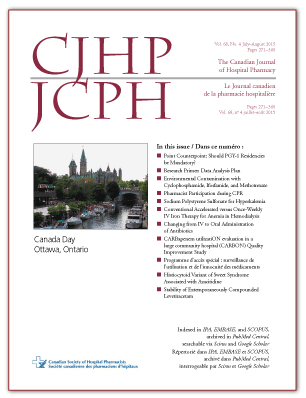Environmental Contamination with Cyclophosphamide, Ifosfamide, and Methotrexate: A Study of 51 Canadian Centres
DOI:
https://doi.org/10.4212/cjhp.v68i4.1467Keywords:
occupational exposure, environmental monitoring, anti - neoplastic agents, cyclophosphamide, ifosfamide, methotrexate exposition professionnelle, surveillance environnementale, antinéoplasiques, méthotrexateAbstract
ABSTRACT
Background: Occupational exposure to hazardous drugs may lead to adverse reproductive effects. There is no safe exposure limit for health care professionals.
Objectives: To monitor levels of cyclophosphamide, ifosfamide, and methotrexate contamination in oncology pharmacy and patient care areas in Canadian health care institutions.
Methods: The study was conducted in 2014. Hospitals with at least 50 acute care beds were invited to participate. At each participating centre, 12 standardized sites (6 in pharmacy areas and 6 in patient care areas) were sampled. The samples were analyzed for the presence of cyclophosphamide, ifosfamide, and methotrexate by ultra-performance liquid chromatography tandem mass spectrometry technology. The limits of detection were 0.36 pg/cm² for cyclophosphamide, 0.95 pg/cm² for ifosfamide, and 0.97 pg/cm² for methotrexate. Descriptive statistical analyses were performed to determine the median, 75th percentile, and maximum levels.
Results: Fifty-one hospitals participated in this descriptive study, and a total of 584 samples were quantified. Overall, 294 (50%) of the samples were positive for cyclophosphamide, 125 (21%) for ifosfamide, and 54 (9%) for methotrexate. The most frequently contaminated sampling sites in pharmacy areas were the front grille inside the hood and the floor in front of the hood and, in patient care areas, the armrest and outpatient clinic counter. The 75th percentiles for surface concentration were 10.8 pg/cm² for cyclophosphamide, 1.59 pg/cm² for ifosfamide, and below the limit of detection for methotrexate.
Conclusions: Relative to 3 other multicentre studies conducted in Quebec over the past few years, the proportion of positive samples remained constant. Nonetheless, the 75th percentile surface concentration of antineoplastic drugs has been decreasing and seems to have reached a plateau. Local (country-specific or region-specific) and attainable goals for surface contamination with hazardous drugs should be set annually, so long as no health-based limit is known.
RÉSUMÉ
Contexte : L’exposition professionnelle à des médicaments dangereux peut causer des effets indésirables sur la reproduction. Aucune limite d’exposition sécuritaire n’est établie pour les professionnels de la santé.
Objectifs : Évaluer les taux de cyclophosphamide, d’ifosfamide et de méthotrexate dans la pharmacie d’oncologie et dans les unités de soins des établissements de santé canadiens.
Méthodes : L’étude s’est déroulée en 2014. Les hôpitaux disposant d’au moins 50 lits de soins de courte durée ont été invités à participer. Dans chacun des établissements participants, des échantillons ont été prélevés dans 12 zones prédéterminées : 6 dans les pharmacies et 6 dans les unités de soins. On a ensuite analysé les échantillons par chromatographie liquide à très haute performance couplée à la spectrométrie de masse en tandem afin de détecter la présence de cyclophosphamide, d’ifosfamide et de méthotrexate. Le seuil de détection était de 0,36 pg/cm² pour la cyclophosphamide, de 0,95 pg/cm² pour l’ifosfamide et de 0,97 pg/cm² pour le méthotrexate. Des analyses statistiques descriptives ont été effectuées afin de déterminer la médiane, le 75e percentile et les taux maximums.
Résultats : Au total, 51 hôpitaux ont participé à cette étude descriptive et 584 échantillons ont été quantifiés. Dans l’ensemble, 294 (50 %) échantillons étaient positifs pour la cyclophosphamide, 125 (21 %) pour l’ifosfamide et 54 (9 %) pour le méthotrexate. Les zones les plus fréquemment contaminées étaient : en pharmacie, la grille avant dans la hotte et le sol devant la hotte; dans les unités de soins, les accoudoirs et le comptoir des cliniques de consultation externe. Le 75e percentile de la concentration de surface était de 10,8 pg/cm² pour la cyclophosphamide, 1,59 pg/cm² pour l’ifosfamide et sous le seuil de détection pour le méthotrexate.
Conclusions : Comparativement à trois autres études multicentriques menées au Québec au cours des dernières années, la proportion de prélèvements positifs demeure la même. Toutefois, le 75e percentile de la concentration de surface d’antinéoplasiques a diminué et semble avoir atteint un plateau. Des objectifs locaux (pour le pays ou selon les régions) et réalisables de contamination de surface par des médicaments dangereux devraient être établis chaque année, et ce, tant qu’aucune limite fondée sur les critères liés à la santé ne sera pas déterminée.
Downloads
Published
Issue
Section
License
Copyright © Canadian Society of Healthcare-Systems Pharmacy.
After publication of a manuscript in the CJHP, the authors of the manuscript must obtain written permission from the CSHP (publications@cshp.ca) before reproducing any text, figures, tables, or illustrations from the work in future works of their own. If a submitted manuscript is declined for publication in the CJHP, all said rights shall revert to the authors. Please note that any forms (e.g., preprinted orders and patient intake forms) used by a specific hospital or other health care facility and included as illustrative material with a manuscript are exempt from this copyright transfer. The CJHP will require a letter from the hospital or health care facility granting permission to publish the document(s).










